Dallas-Fort Worth Crane Accident Lawyer
Crane accidents are a significant safety concern for manufacturing and construction industries nationwide – and Texas is no exception. The Lone Star State leads the way in crane fatalities, leaving families devastated and companies facing liability and litigation.
While cranes are essential for lifting and moving heavy materials, these towering machines come with major risks. A single mishap can lead to catastrophic consequences, affecting not just the workers operating them but also bystanders and nearby property.
If you have been injured or a loved one killed in a crane accident in North Texas, it’s important to seek help from an experienced Dallas-Fort Worth crane accident lawyer as soon as possible. You may be entitled to substantial compensation for medical expenses, lost wages, pain and suffering, and more.
In this article, a Dallas-Fort Worth crane accident attorney at Varghese Summersett Injury Law Group explains why crane accidents occur, the process for recovering compensation, and how our law firm can help.
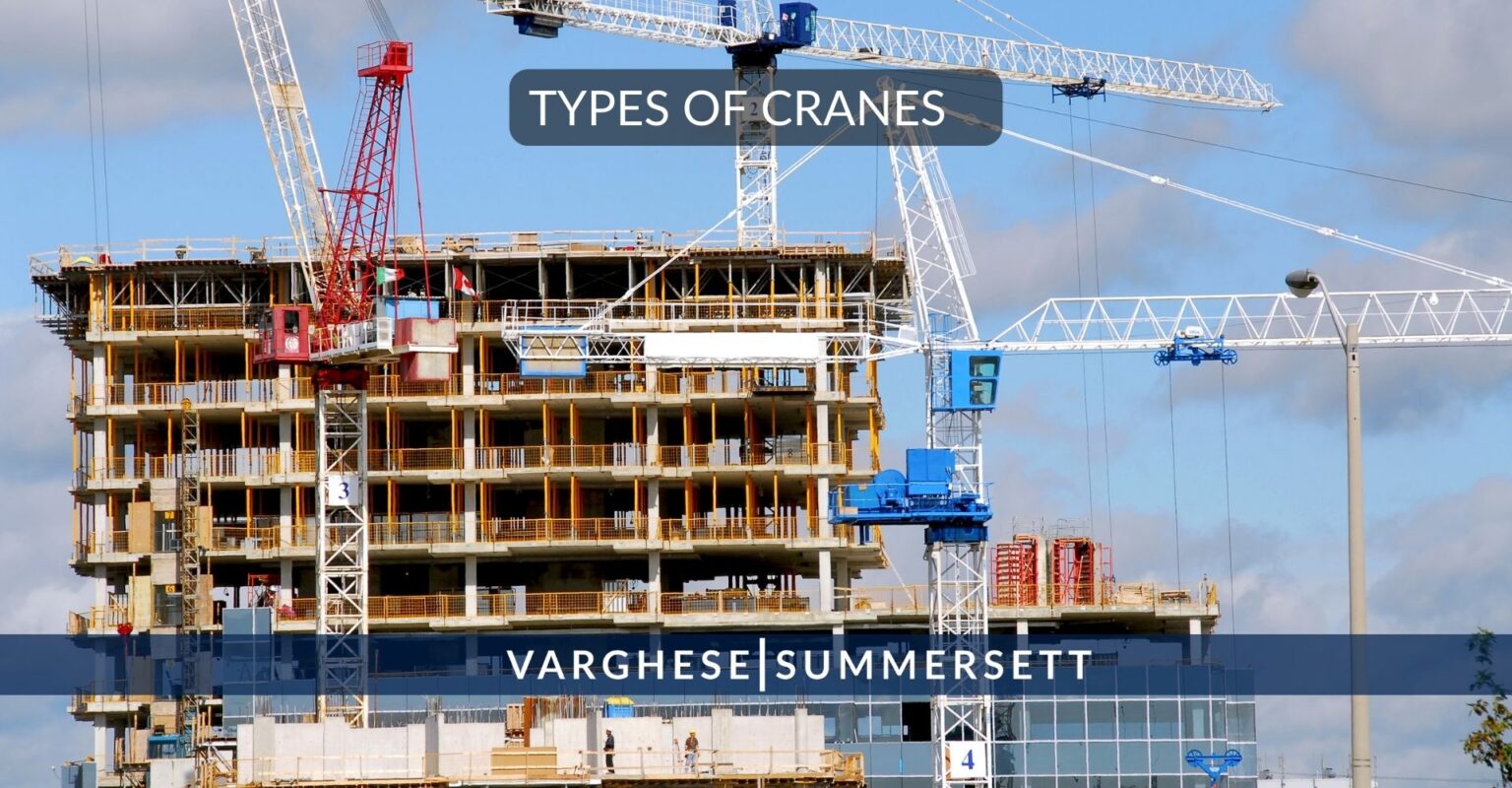
Common Types of Cranes
Cranes come in various designs, each tailored for specific tasks and environments. Some of the more prevalent types of cranes include:
- Overhead Cranes: Commonly found in warehouses and factories, these cranes have a beam running along the ceiling with a hook and line mechanism, crucial for steel manufacturing.
- Truck Mounted Cranes: These cranes are mobile and typically have a lifting capacity of up to 1,300 short tons.
- Crawler Cranes: Also known as “crawlers,” these are mounted on tracks, similar to tank treads.
- Floating Cranes: Used predominantly in the offshore industry, especially for constructing bridges over water.
Other types of cranes that could be involved in accidents include aerial cranes, all-terrain cranes, bulk-handling cranes, carry deck cranes, deck cranes, fixed cranes, gantry cranes, hammerhead cranes, jib cranes, level luffing cranes, loader cranes, overhead cranes, pick-and-carry cranes, railroad cranes, self-erecting cranes, sidelift cranes, stacker cranes, telescopic cranes, and telescopic handler cranes.
When seeking a Dallas-Fort Worth crane accident personal injury lawyer it’s important to choose a firm that has the expertise to handle cases involving various crane types, extensive knowledge of state and federal safety regulations, and a proven track record of successfully representing clients in complex personal injury cases. Varghese Summersett Injury Law Group stands out from the rest with a seasoned team dedicated to pursuing justice and adequate compensation for victims of crane accidents.
Crane Design
Cranes are marvels of engineering, designed to lift weights far beyond human capacity. Their design is a culmination of centuries of mechanical evolution. Understanding their core components can provide insights into their safe operation and also help you understand the reasons behind potential accidents.
The Lever
At the heart of every crane is the principle of the lever. This simple machine allows cranes to lift heavy objects by distributing weight and providing a mechanical advantage. The longer the distance from the fulcrum (or the pivot point), the more weight the crane can lift on the other end. This principle ensures that cranes don’t tip over under the weight of the objects they’re lifting.
The Pulley
Another fundamental component of cranes is the pulley system. Pulleys reduce the effort needed to lift a load by changing the direction of the force applied. In cranes, multiple pulleys are often used in tandem, creating a block-and-tackle system that provides an even greater mechanical advantage, allowing for lifting extremely heavy objects with minimal effort.
The Hydraulic Cylinder
Modern cranes often employ hydraulic systems to power their lifts. Hydraulic cylinders use the principle of fluid mechanics, where a liquid in a confined space can be used to transmit force. When pressure is applied to the liquid, it moves the piston inside the cylinder, which in turn lifts the load. This system allows for smooth and controlled movement, making it ideal for precision tasks.
The design of cranes is a testament to human ingenuity, combining age-old principles with modern technology to create machines that have become indispensable in today’s construction landscape. Understanding these basic principles may be helpful when consulting with a Dallas-Fort Worth crane construction accident attorney.
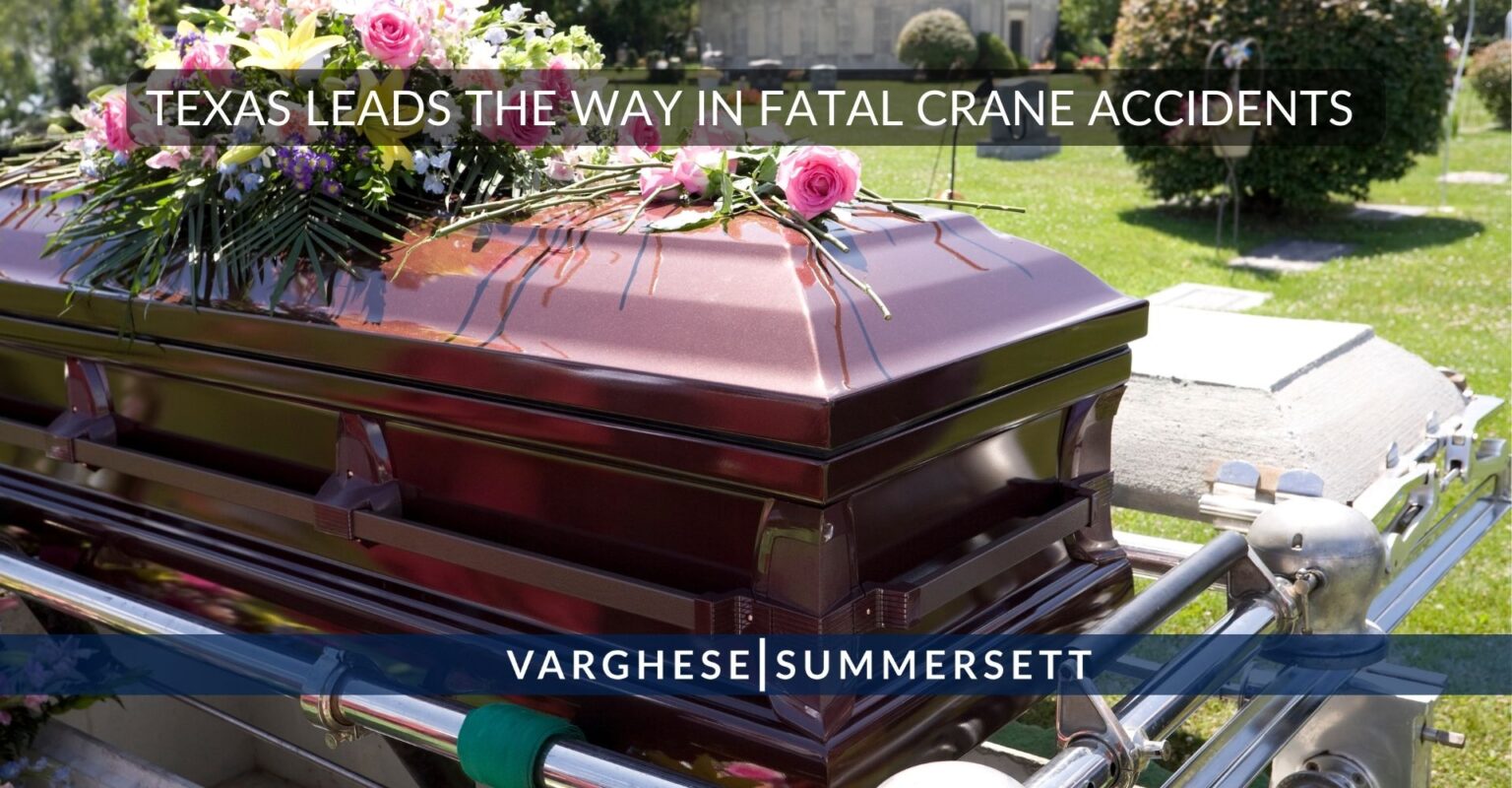
Deadly Crane Accidents: Texas Leads the Way
Cranes are used to lift and move heavy objects on construction and industrial sites, but they can also be extremely dangerous if not operated safely. The most recent data on crane accidents from the U.S. Bureau of Labor and Statistics covers a 7-year period from 2011 to 2017. During this time frame, there were 293 crane-related deaths, averaging 42 deaths per year. Here’s a look at the most common causes of crane fatalities during that time frame:
- Struck by Object Equipment: More than half of all of these fatal crane injuries – 154 to be exact – involved a worker being struck by an object or equipment. About three-fifths of these cases – 91 of 154 fatalities – involved the worker being struck by a falling object or equipment. In 79 cases, the worker was struck by an object falling from or put in motion by a crane.
- Transportation incidents: About 13 percent – or 39 of the fatalities – were caused by a transportation incident, which refers to an accident or event involving the movement of cranes.
- Falls to a lower level: About 14 percent – 41 of the fatalities – were caused by falls to a lower level, which refers to accidents where an individual, usually a worker, falls from one elevation to a lower one.
Fatal Injuries Involving Cranes by State
As mentioned, Texas had more fatal injuries caused by cranes than any other state from 2011 to 2017. In fact, Texas had more fatal injuries than the next three states combined. The following table shows the five states with the most fatal injuries due to cranes:
| State of Incident | Number of Fatal Injuries Involving Cranes |
|---|---|
| Texas | 50 |
| Florida | 16 |
| New York | 16 |
| California | 14 |
| Illinois | 14 |
Losing a loved one in a crane accident is a devastating tragedy, and while no action can undo this loss, you have the right to seek justice and accountability. In Texas, you may be entitled to file a wrongful death suit, a step that can provide financial relief for damages and send a strong message about crane or construction site safety. Please take a moment to watch this video by attorney Benson Varghese, who explains wrongful death litigation in Texas.
Common Causes of Crane Accidents in Texas
Given the state’s vast construction and industrial sectors, crane accidents are a significant concern in Texas. While these machines are essential for lifting and transporting heavy loads, they also pose considerable risks when not operated or maintained correctly.
An estimated 90 percent of crane accidents can be attributed to human error, underscoring the need for employers to properly train employees and ensure the crane is safe. Here’s a look at the primary causes of crane accidents in Texas:
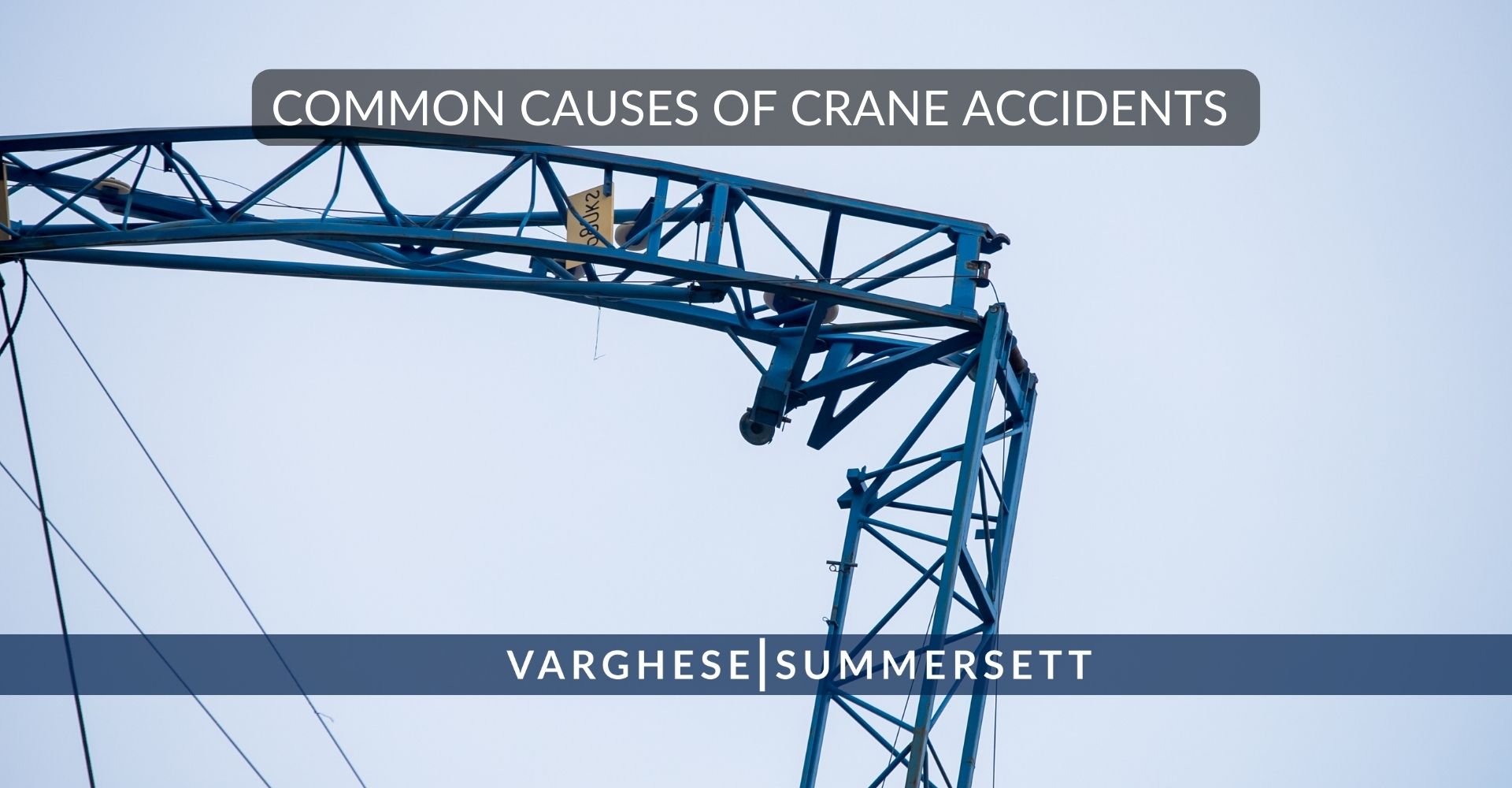
Contact with Crane or Load
Workers or bystanders often suffer severe injuries or fatalities when struck by a crane or its load, especially during abrupt swings or sudden, unexpected movements. This type of accident can also occur if individuals get trapped between the crane and an immovable object. Employers or site managers failing to implement safety zones or proper operational protocols may be found negligent in these incidents.
Transportation Incidents
Transportation incidents occur when cranes are in transit, and may involve collisions, sudden shifts of the load, or other movement-related mishaps. The responsibility often lies with employers or crane operators who fail to follow transportation safety standards or neglect environmental assessments before moving the crane.
Electrocution Accidents
When cranes or their components, such as booms or cables, come into contact with overhead power lines, it can result in electrocution, causing significant injuries or fatalities. Negligence may be attributed to employers or supervisors who fail to identify electrical hazards or neglect to establish safe operating procedures near power lines.
Crane Assembly Accidents
Crane assembly or disassembly can be perilous if not performed according to the manufacturer’s guidelines. Mishaps often stem from poor communication or procedural errors. Negligence can involve employers, assembly teams, or supervisors not adhering to or enforcing the proper assembly guidelines.
Crane Boom Collapse
Overextending the crane boom past safe operational limits can result in a crane collapse, often due to immense strain on the crane’s structural components. Manufacturers or engineers might be negligent for not providing clear specifications, while operators or supervisors could be at fault for ignoring operational limits.
Crane Overturning
Crane tip-overs can result from overloading, improper setup, or unstable ground conditions, leading to catastrophic consequences. Potential negligence may be on the part of the operators, site supervisors, or even the construction site owners for not assessing ground stability or load parameters.
Structural Failures
Failures can occur due to material defects, lack of maintenance, or incorrect assembly, causing cranes to break down, potentially leading to accidents. Manufacturers, maintenance crews, or assembly teams could be held responsible for such incidents due to negligence in their respective duties.
Inadequate Crane Operator Training
Operators must be thoroughly trained to understand crane capacities and to assess operational conditions. Employers or training providers may be negligent if operators lack the necessary training, leading to improper handling or judgment errors.
Crane Load Accidents
Individuals within the crane’s operational radius are at risk of being struck by moving loads, resulting in serious injuries. Employers or site managers may be negligent for not establishing clear safety protocols or failing to control access to high-risk areas.
Fall Accidents
Unstable platforms or adverse wind conditions can cause fall accidents, posing significant risks to crane operators or other workers. Employers or contractors could be held negligent for not providing adequate fall protection systems or for failing to monitor weather conditions.
Falling Objects
Loose or unsecured objects can fall from heights, presenting grave dangers below. Site supervisors or crane operators may be negligent for not securing loads properly or for failing to maintain equipment used in hoisting.
Load Drops
Dropped loads, often due to exceeding crane capacities or equipment failure, can lead to severe site accidents. Negligence can be attributed to operators, employers, or maintenance teams not respecting load limits or overlooking the condition of the lifting equipment.
In all these instances, identifying the liable parties involves a thorough investigation of the accident circumstances. Whether it’s the crane operators, site supervisors, employers, manufacturers, or maintenance teams, any party that fails to uphold safety standards or neglects proper operational procedures may be found negligent.
When injured in a crane accident in North Texas, it’s imperative to consult with a Dallas-Fort Worth crane accident lawyer who understands the complexities of these incidents. Varghese Summersett has a proven track record of representing victims and ensuring they receive the justice and compensation they deserve.
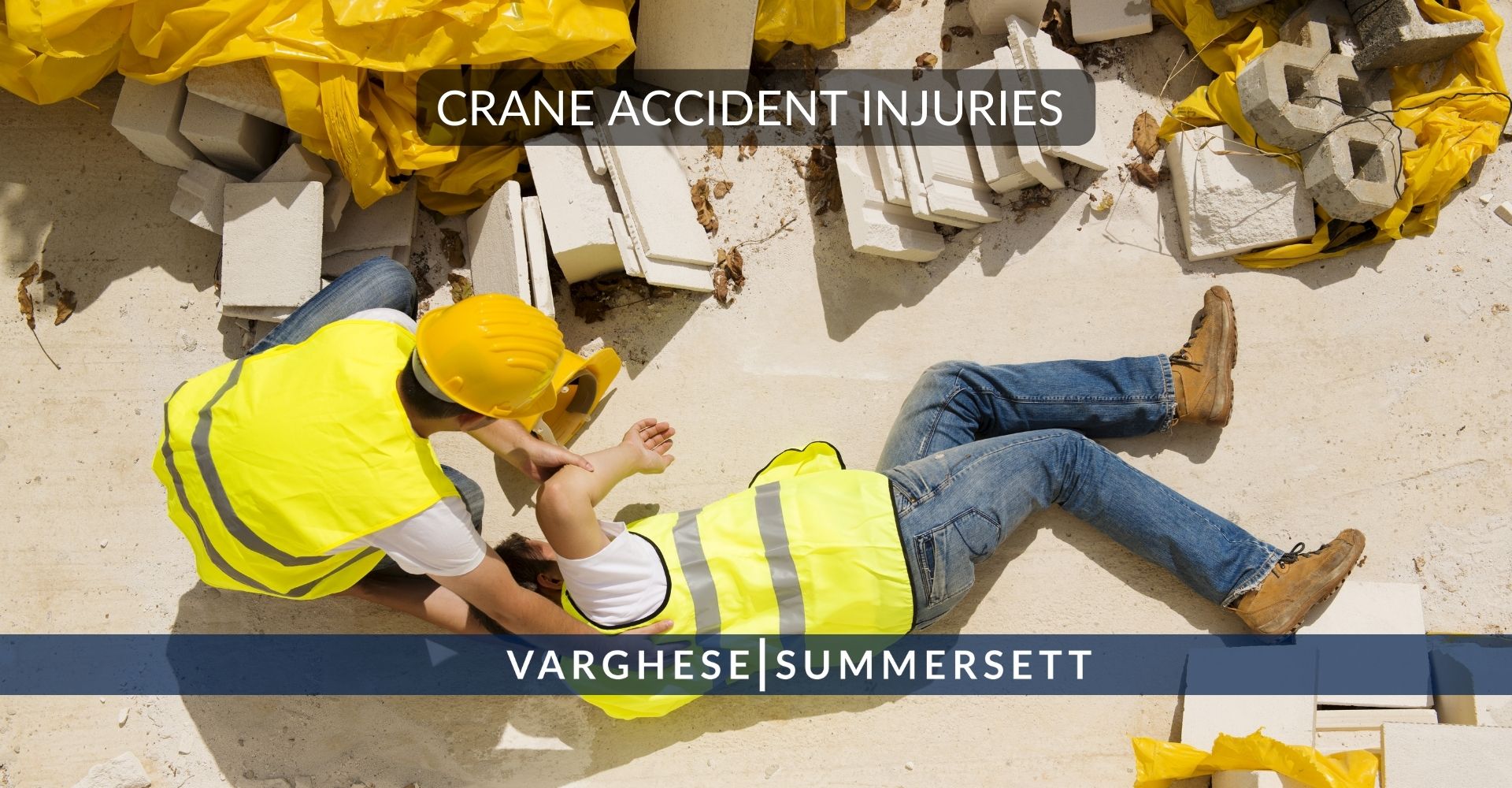
Common Injuries Suffered in Texas Crane Accidents
Crane accidents, given their nature, can lead to severe and often life-altering injuries. The sheer size and weight of cranes, combined with the heights they operate at, make any mishap potentially catastrophic. Here are some of the most common injuries that victims of crane accidents in Texas suffer:
Traumatic Brain Injuries (TBIs)
When a worker or bystander is struck by a falling object or experiences a fall from a significant height, the impact can lead to traumatic brain injuries. TBIs can range from mild concussions to severe brain damage, affecting cognitive functions, memory, and even personality.
Spinal Cord Injuries
Crane accidents can result in injuries to the spinal cord, leading to partial or complete paralysis. Such injuries can drastically change a person’s life, requiring long-term medical care, rehabilitation, and assistive devices.
Amputations
In some severe crane accidents, victims might suffer injuries so grave that a limb needs to be amputated. This not only leads to physical challenges but also significant psychological trauma.
Electrocution & Burns
As previously mentioned, cranes coming into contact with live power lines can lead to electrocution. This can result in severe burns, cardiac arrest, and even death.
Crush Injuries
If a crane tips over or if its load drops, workers or bystanders can be trapped underneath, leading to crush injuries. These injuries can affect internal organs, muscles, and bones.
Psychological Trauma
Beyond the physical injuries, crane accident victims often suffer from psychological trauma. The experience can lead to post-traumatic stress disorder (PTSD), anxiety, depression, and other mental health challenges.
Broken or Fractured Bones
The force from a crane accident can easily break or fracture bones. Depending on the severity, victims might need surgeries, physical therapy, and extended periods of rest to recover.
Lacerations and Abrasions
Flying debris, shattered glass, or metal shards from a crane accident or construction accident can cause deep cuts or abrasions. If not treated promptly, these can lead to infections or other complications.
Cranes pose significant threats not only to construction workers but also to pedestrians, cyclists, and motorists. If safety protocols are not strictly followed, the consequences can be dire.
If you or a loved one has suffered any of these injuries due to a crane accident in Texas, it’s essential to seek legal representation as soon as possible. You may be entitled to compensation for your medical bills, long-term medical care, pain and suffering and more. A Dallas-Fort Worth crane accident lawyer at Varghese Summersett can help.
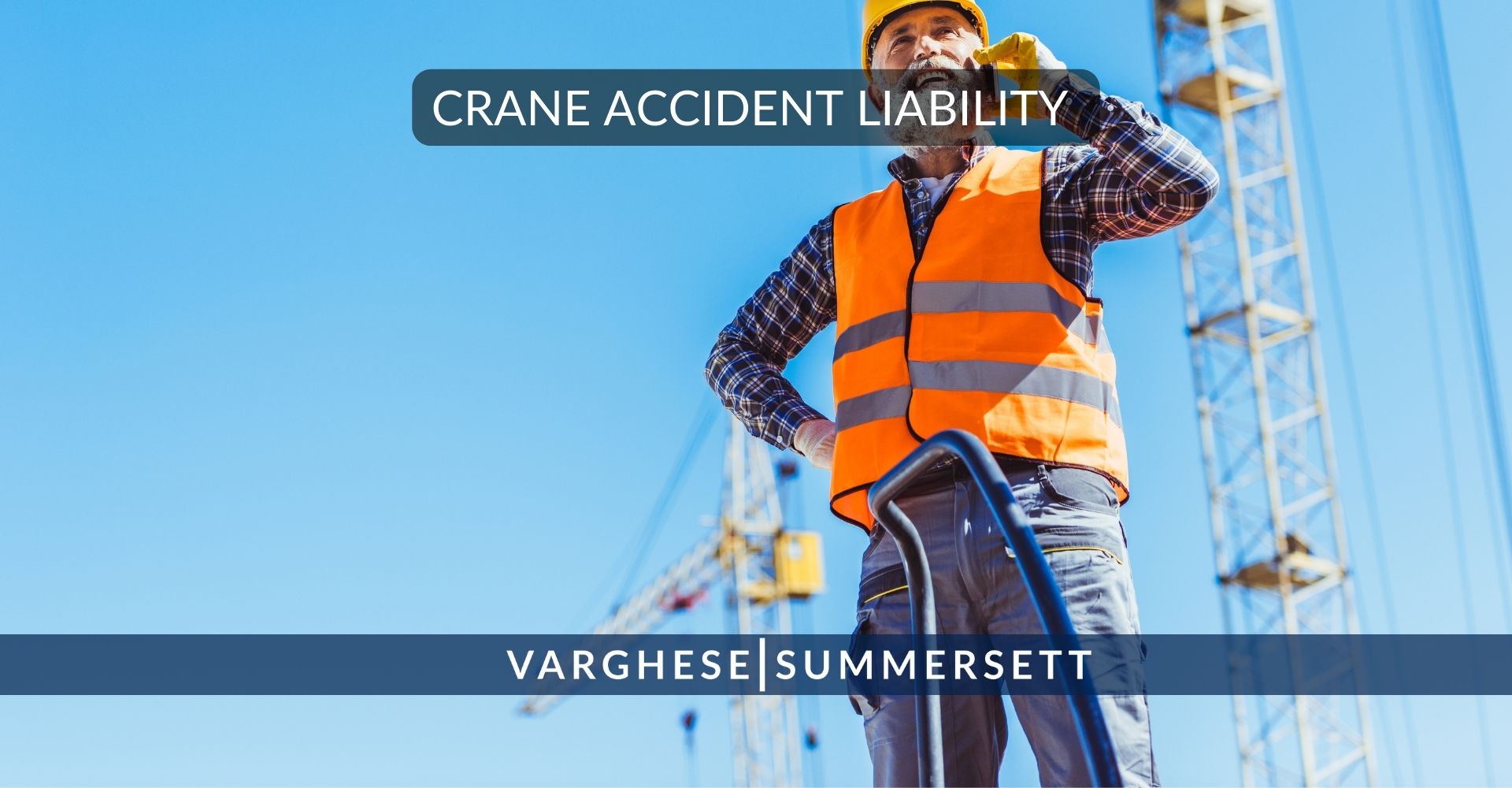
Liability for Crane Accidents
Crane accidents can have devastating consequences, and determining liability is a complex process. In Texas, multiple parties can be held responsible for crane-related injuries, depending on the circumstances leading up to the accident. This could include general contractors, subcontractors, crane operators, manufacturers, maintenance providers, crane owners, property owners, engineers, and other third parties. Here’s a breakdown of potential liable parties:
General Contractors
- Role: They oversee the entire construction project and ensure that all operations run smoothly.
- Liability: If they fail to ensure the safety of the construction site or do not adhere to safety protocols, they can be held liable for any accidents.
Subcontractors
- Role: They are hired by the general contractor to perform specific tasks on the construction site.
- Liability: If a subcontractor’s negligence or failure to follow safety guidelines leads to an accident, they can be held responsible.
Crane Operators
- Role: They are responsible for operating the crane safely and efficiently.
- Liability: If the crane operator’s negligence, lack of training, or failure to adhere to safety protocols results in an accident, they can be held accountable.
Manufacturer
- Role: They design and produce the crane and its components.
- Liability: If a defect in the crane or any of its parts leads to an accident, the manufacturer can be held liable for the resulting injuries.
Maintenance Providers
- Role: They ensure that the crane is in good working condition and perform regular maintenance checks.
- Liability: If they fail to identify or rectify a defect or malfunction in the crane, leading to an accident, they can be held responsible.
Crane Owners
- Role: They own the crane and lease or rent it out for construction projects.
- Liability: If the crane owner fails to maintain the crane or provides a faulty crane for a project, they can be held liable for any accidents.
Property Owners
- Role: They own the property where the construction project is taking place.
- Liability: If the property conditions contribute to the accident, such as unstable ground causing the crane to tip over, the property owner can be held responsible.
Engineers
- Role: They design the construction project and ensure that all structures are sound.
- Liability: If an engineering flaw contributes to a crane accident, the engineer can be held liable.
Other Third Parties
- Role: This includes any other party involved in the construction project, such as suppliers or transporters.
- Liability: If their actions or negligence contribute to the crane accident, they can be held responsible.
Establishing liability requires a thorough investigation, and consulting with a Dallas-Fort Worth crane accident lawyer, like those at Varghese Summersett, is critical to ensuring that all potential negligence is uncovered, evidence is preserved, and the rights of the injured parties are protected.
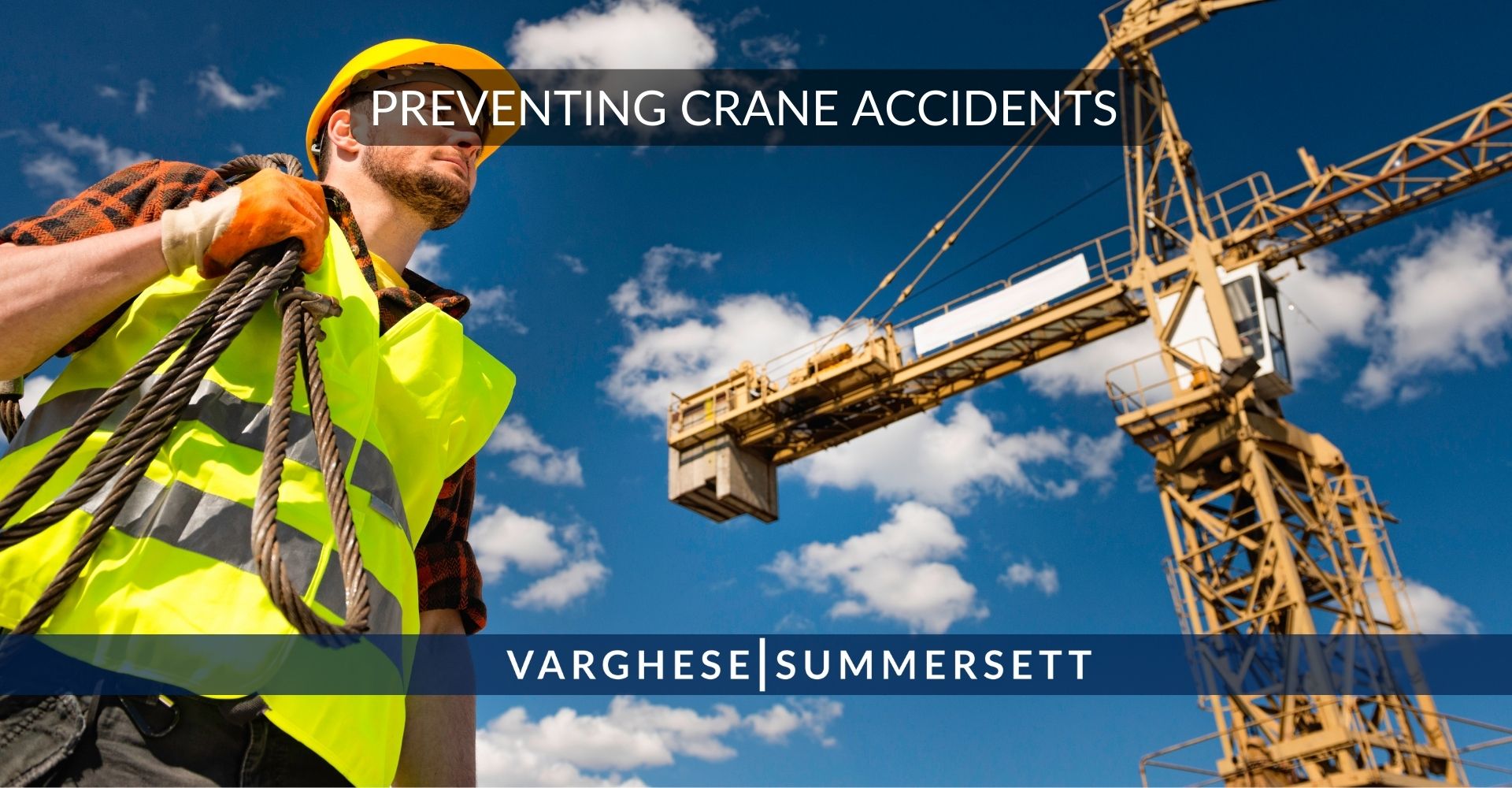
Crane Accident Prevention in Texas
Preventing crane accidents in Texas is paramount to ensuring the safety of workers and the general public. Here are crucial steps that can significantly reduce the risk of crane-related incidents:
Training: It’s essential that all crane operators undergo comprehensive training and obtain the necessary certifications, ensuring they’re fully equipped to handle the equipment safely.
Inspections: Regular, thorough inspections of cranes and all related equipment are vital to identify any potential issues before they lead to accidents.
Safe Operating Practices: Operators and site managers must strictly adhere to established safety protocols and the crane manufacturer’s guidelines during operations.
Use Safety Equipment: Utilizing appropriate safety gear, such as harnesses and hard hats, can significantly reduce the risk of injury during crane operations.
Ground Conditions: Before any lifting, it’s crucial to confirm that the ground is sufficiently stable and capable of supporting the crane’s weight to prevent tipping or sinking.
Clear Communication: Effective, clear communication between crane operators and ground personnel is essential to coordinate safe movements and prevent mishaps.
Weather Monitoring: Keeping a close eye on weather conditions is critical; operations should be suspended during adverse conditions like high winds or lightning.
Avoid Overloading: Never exceed the crane’s specified load capacity, as overloading can lead to tipping, structural damage, or complete failure.
Establish Drop Zones: Clearly mark hazardous areas where loads will be moved or placed, ensuring personnel stay clear of these zones to avoid serious injury from falling objects.
Power Line Safety: Always maintain a safe distance from power lines to prevent electrocution risks associated with potential contact.
Routine Maintenance: A schedule of regular maintenance and repairs is vital to keep all parts of the crane in good working condition.
Legal Compliance: Strict adherence to all OSHA standards and local regulations is not only a legal requirement but also a critical safety practice.
Consultation: Regular consultation with crane safety experts and, in the event of an accident, early engagement with experienced crane accident attorneys is crucial for ongoing safety and legal protection.
By following these practices, companies can dramatically decrease the likelihood of crane accidents, protecting both their workers and their business interests.
OSHA Standards Related to Crane Accidents Prevention
The Occupational Safety and Health Administration (OSHA) is instrumental in ensuring safety and preventing accidents in the construction industry, especially those involving cranes. Here are the key OSHA standards related to crane accident prevention:
- OSHA 1926.1400 – Scope and Application: This standard delineates the regulations related to cranes and derricks used in construction. It defines the equipment covered and sets the foundation for specific safety requirements.
- OSHA 1926.1401 – Definitions: This section offers definitions for crucial terms related to crane and derrick operations, ensuring clarity and consistency in interpreting the regulations.
- OSHA 1926.1402 – Ground Conditions: OSHA mandates that employers ensure the ground conditions can safely support the crane’s weight. This includes measures to prevent hazards like sinking or tipping.
- OSHA 1926.1403 to OSHA 1926.1406 – Assembly and Disassembly: Accidents during the assembly and disassembly of cranes are a significant cause of worker fatalities. This section details regulations for the assembly and disassembly of cranes, including specific procedures and safety precautions.
- OSHA 1926.1407 to OSHA 1926.1409 – Power Line Safety: Electrocutions from cranes, loads, or load lines coming into contact with power lines are a major cause of construction worker fatalities. These OSHA standards incorporate procedures that employers must follow when power line hazards are near the crane operation area.
- Section 1926.1412 – Inspections: To ensure equipment safety, this standard mandates various inspections. All equipment is subject to shift inspections, monthly and annual inspections, and wire rope inspections. Additionally, specific special inspections must be conducted under certain circumstances, such as after assembly, before and after erection for tower cranes, for equipment used in severe service, equipment not regularly used, and for modified, adjusted, or repaired equipment.
It’s essential to note that negligence by general contractors, subcontractors, crane repair and maintenance providers, and other entities can lead to severe crane accidents and injuries. If you’ve been injured in such an accident, consulting with a Dallas-Fort Worth crane accident lawyer is crucial to hold the at-fault parties accountable and recover the maximum financial compensation for your injuries and losses.
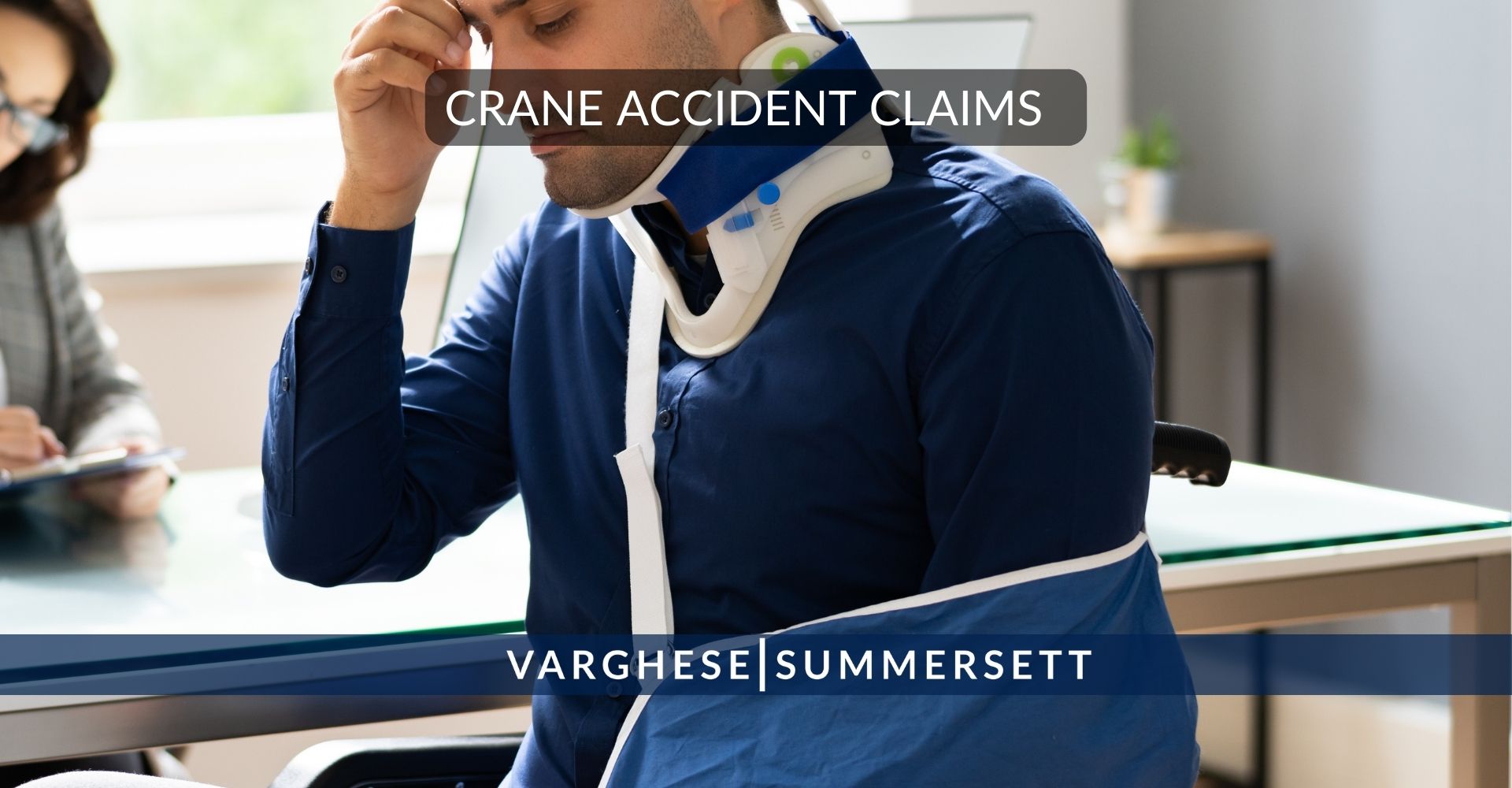
Types of Crane Accident Claims
Crane accidents can lead to various legal claims, depending on the circumstances surrounding the incident. Understanding the different types of claims can help victims and their families pursue the right legal avenues for fair compensation. Here are the primary claims that can arise from crane accidents:
Wrongful Death
- Definition: When a crane accident results in the death of a worker or bystander, the deceased’s family can file a wrongful death lawsuit against the responsible parties.
- Liability: This claim can be brought against any party whose negligence or wrongful act led to the death, including employers, crane manufacturers, maintenance providers, or other third parties.
- Compensation: Families can seek compensation for funeral expenses, loss of consortium, loss of financial support, and emotional distress.
Defective Products
- Definition: If a crane accident is caused by a defect in the crane or any of its components, victims can file a defective product lawsuit against the manufacturer or distributor.
- Liability: Manufacturers, distributors, and retailers can be held liable if they provided a faulty product that led to the accident.
- Compensation: Victims can seek compensation for medical costs, lost wages, pain and suffering, and other damages.
Personal Injury
- Definition: Workers or bystanders injured in a crane accident can file a personal injury claim to seek compensation for their injuries.
- Liability: This claim can be brought against any party whose negligence led to the accident.
- Compensation: Victims can seek compensation for medical bills, rehabilitation costs, lost wages, pain and suffering, and other related expenses.
Workers Compensation Claims
- Definition: If a worker is injured in a crane accident while on the job and their employer carries workers compensation insurance, they can file a workers’ compensation claim. Regardless of workers’ compensation status, if the injury was caused by a third party’s negligence (for example, a negligent subcontractor, equipment manufacturer, or property owner), the injured worker might have the right to file a personal injury lawsuit against that third party.
- Liability: Employers are typically responsible for providing workers’ compensation benefits, regardless of fault.
- Compensation: Workers can receive benefits for medical expenses, a portion of lost wages, and disability benefits. However, it does not provide compensation for pain and suffering
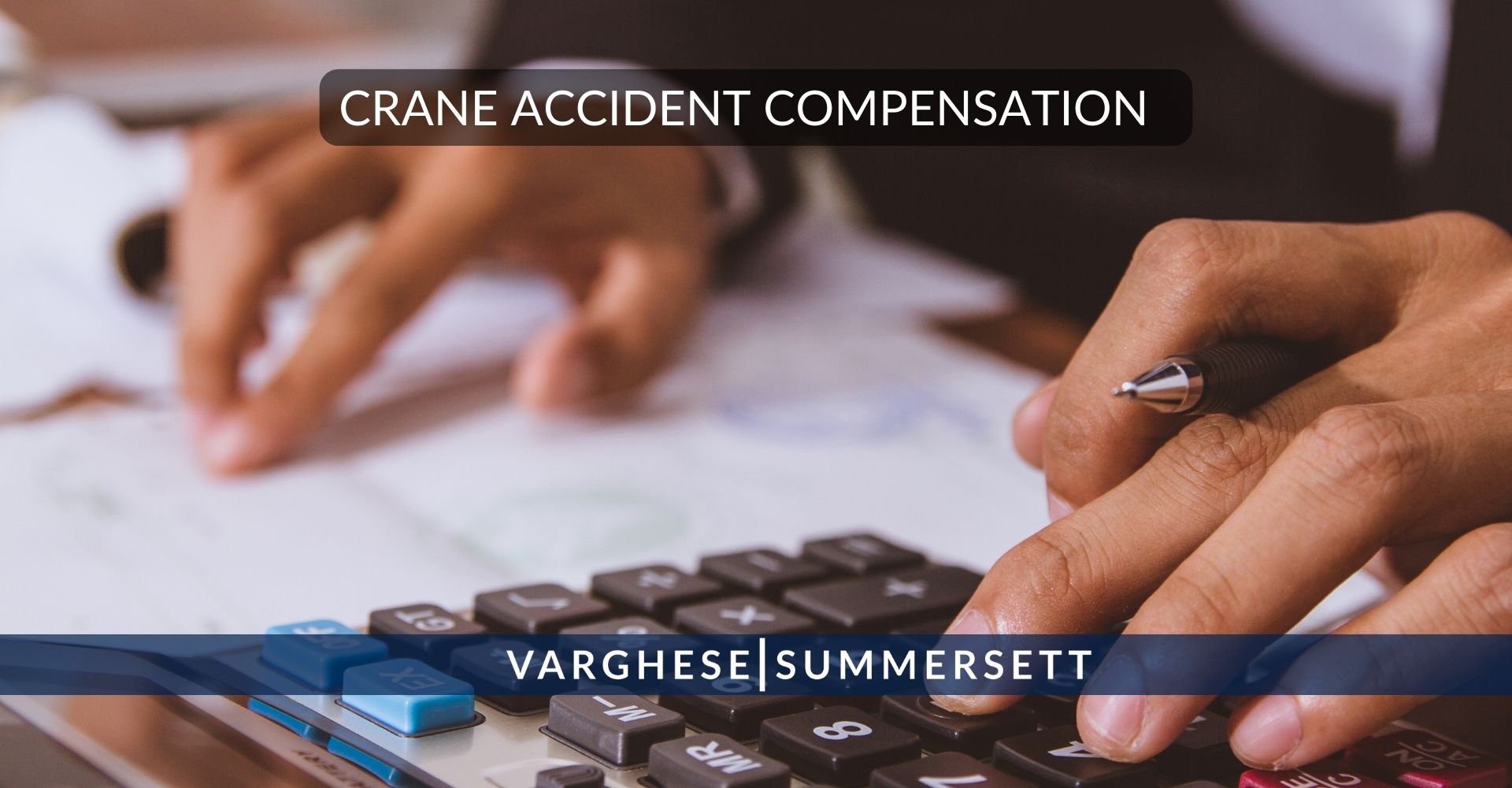
Compensation in Crane Accident Cases
If you’ve been injured in a crane accident, it’s important to understand the types of damages that may be recoverable to ensure you are adequately compensated. In legal terms, “damages” refer to the monetary compensation awarded to a person who has suffered injury or loss due to the wrongful conduct of another party. In crane accident cases, recoverable damages are typically classified into three categories: economic, non-economic, and, in some cases, punitive.
Economic Damages
- Medical Expenses: Compensation for medical bills incurred due to the crane accident, including hospital stays, doctor visits, surgeries, physical therapy, prescription medications, and any anticipated future medical expenses related to the injury.
- Lost Wages: Compensation for the loss of income due to time missed from work, and if the injury impacts the ability to continue working in the same capacity, future lost earning capacity may also be considered.
- Property Damage: If any personal property was damaged in the crane accident, you might be entitled to reimbursement for repairs or replacement.
Non-Economic Damages
- Pain and Suffering: Compensation for physical pain and emotional distress endured as a result of the injuries sustained in the crane accident.
- Loss of Consortium: If the injury adversely affects the relationship with a spouse, additional damages may be awarded for loss of companionship or loss of marital benefits, including affection, solace, comfort, companionship, society, assistance, and sexual relations.
- Emotional Distress: Serious accidents can result in psychological impacts such as anxiety, depression, and post-traumatic stress disorder (PTSD), for which you can be compensated.
- Loss of Enjoyment of Life: If the injuries prevent you from enjoying day-to-day pursuits like hobbies, exercise, and other recreational activities, you might be entitled to “loss of enjoyment” damages.
Punitive Damages
Unlike economic and non-economic damages, punitive damages are not meant to compensate the injured party but rather to punish the at-fault party for particularly reckless or negligent behavior and to deter similar conduct in the future. These are not awarded in every case, as they require proof of egregious behavior, such as a company knowingly operating with faulty cranes or a crane operator working under the influence of drugs or alcohol.
In any legal claim, it’s essential to have an experienced attorney who can accurately calculate the total damages you’re entitled to and advocate effectively on your behalf.
If you or a loved one has been involved in a crane accident in North Texas, an experienced Dallas-Fort Worth crane accident lawyer at Varghese Summersett can help. Keep reading to find out how.

How a Dallas-Fort Worth Crane Accident Lawyer Can Help
The experienced team at Varghese Summersett Injury Law Group helps individuals and families recover compensation for crane accidents and we can help you, too. Our attorneys and legal professionals have the experience, skills, and resource to handle the most complex crane accident. A Dallas-Fort Worth crane accident lawyer at our firm will:
- Thoroughly investigate the accident and gather crucial evidence;
- Identify all liable parties and insurance policies;
- Document your treatment plan;
- Calculate the full extent of damages, including medical and rehabilitation expenses, lost income and wages, and pain and suffering;
- Aggressively negotiate with insurance companies on your behalf;
- File a personal injury lawsuit if a just settlement can’t be reached
- Fight for you in court if your case goes to trial to get you maximum compensation.
Talk to a Dallas-Fort Worth Crane Accident Lawyer Today
At Varghese Summersett Injury Law Group, we understand the physical, emotional and financial hardship that comes with a crane injury. We believe everyone should have exceptional legal help, regardless of their bank account. We offer a free consultation for potential clients and also work on contingency, which means you don’t have to pay anything until we recover compensation on your behalf.
You will never pay us a dime if we don’t recover compensation. That’s how confident we are in our experience and skills. Contact a Dallas-Fort Worth crane accident lawyer at our firm today to learn more about how we can help you. Time is of the essence. Call 817-207-4878 (HURT).
